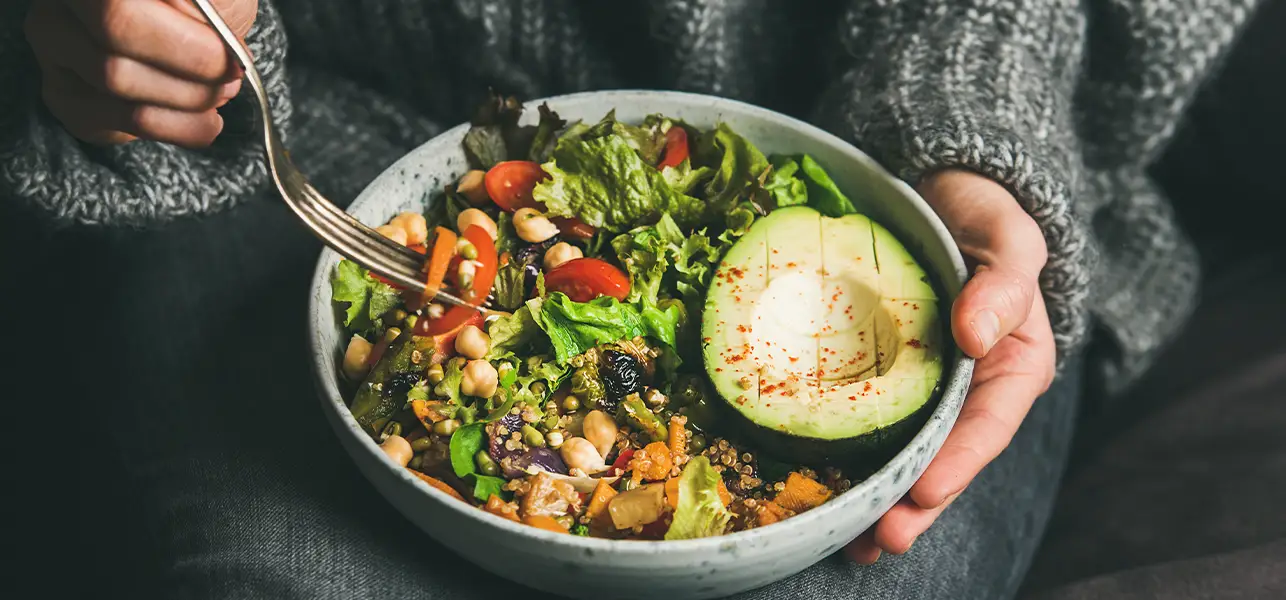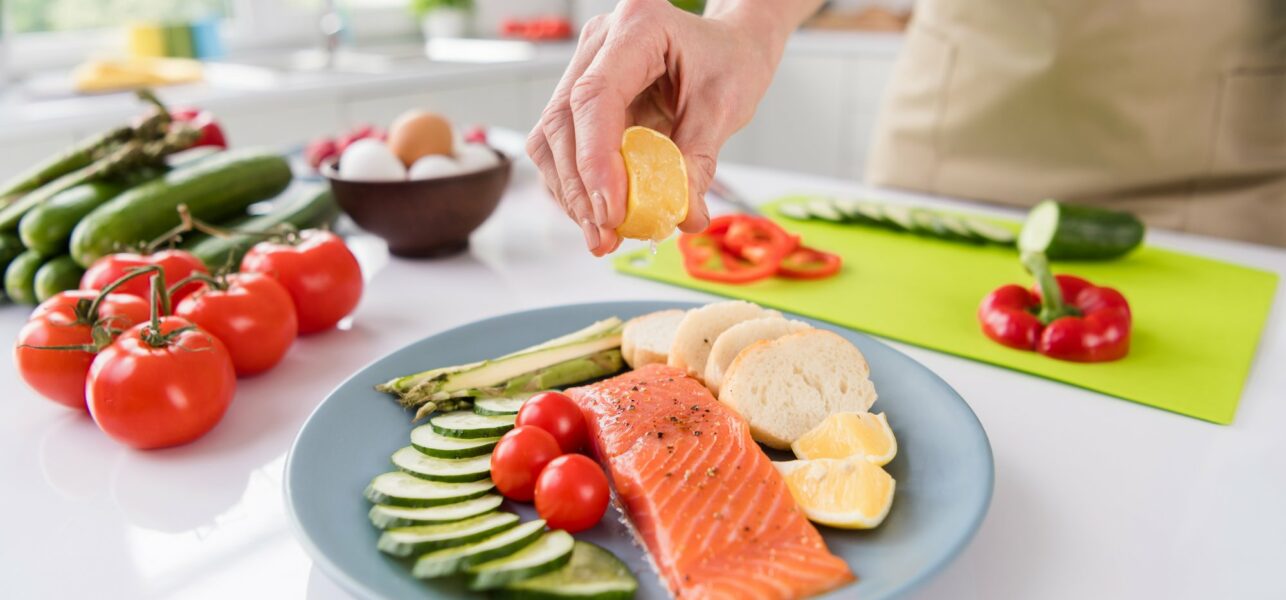42 Practical Diabetes Eating Tips You Can Implement in Your Life Today

Shutterstock.com
You’re not new to this whole diabetes thing, but managing your diet and eating healthy could be easier.
Yes, you know how to measure your glucose levels. And yes, you know what food you definitely need to avoid. But you still spend way too much time and energy on managing your meals, right?
Below you’ll find a collection of quick, simple tips to make your diabetes-dominant lifestyle a little more care-free and a lot more manageable!

Advertisement
The Basics
- Do not skip meals! If you miss a meal, you will go hungry, and when you’re super hungry, it’s super easy to overeat during your next meal.
- Eat at a slower pace and take a little time between bites. The moms of the world were right – “Wait for it to hit your stomach before you get seconds.”
- Stock ready-to-drink cold water in the fridge and always keep a bottle of water handy to sip on all day long.
- Pie-graph your plate:
- Fill one-quarter of your plate with proteins, lean ones like turkey or chicken.
- Fill one-quarter of your plate with a serving of whole grains or a starchy vegetable like potatoes.
- Fill half your plate with green, non-starchy vegetables like broccoli, beets, and salad greens.
- Alcohol should be enjoyed in moderation. Women should limit their intake to one standard drink a day, and men should limit themselves to two standard drinks daily.
- Start a food log or get a ready-made meal plan to track your body’s blood glucose levels. Seeing what you are eating is a great way to step back and reevaluate your choices. Are you sticking to your meal plan? If you are – good. You are on the right track and you know that the food you eat is well-balanced.
- Bring a healthy lunch and a few prepared snacks to snack on throughout the day. Doing so will help you be less tempted by convenient junk-food options out there in the world.
- Seek expert solutions – a professional diabetes-oriented meal plan could do wonders for your health and your weight loss goals. Why not? You don’t have to do it all on your own!
Grocery Shopping
- Plan ahead! Try to plan out at least a week’s worth of meals before head out for groceries. Having a set meal plan will help you to plan weeks ahead and pre-order food in advance.
- Check what you still have at home before you go! This will save you money and will keep your meal plan from being derailed.
- Make a grocery list of only what you need for your weekly plan. And stick to it! The less junk of not-so-good foods you purchase, the less likely you’ll fall off your healthy diet.
- Suppose you don’t know already – DON’T SHOP HUNGRY! This is the path to the dark side.
- Spend your time in the produce section or the aisles filled with fresh fruit and veggies, dairy or alternatives, meat, fish, poultry, and eggs. Don’t go in the chip or candy aisle! Always stick to ingredients suggested in your meal plan.
- If you need lesser-perishable staples, look low on the aisles. There you’ll find all the healthy offerings such as dried beans and lentils, olive oil, vinegar, canned tuna. The same goes for the freezer section – stock up on frozen fruit and vegetables (the ones without sauces).
- Be on the lookout for packaging saying things like “lower in fat” or “reduced sugar.” This doesn’t make the food item automatically healthy.
- Purchase fruit that is fresh, frozen, canned in water or its juice. Any with syrups or added sugars are a hard no-go.
- Stick with plain old water! If you must splurge, purchase sugar-free soft drinks or unsweetened iced tea instead of fruity beverages, regular pop, or sweetened tea.
- Load up on fruits and veggies that are in season and deep in color. Keep an eye out for good looking stuff like spinach, carrots, peaches, and berries. Color = Flavor + Healthy
Food Labels
- Don’t be fooled by ridiculous serving sizes! Check the Serving Size first so you can keep the other numbers in perspective. See what your meal plan requires. If a package has five servings and you’re going to eat the whole thing, you’re going to have to multiply all the calories, carbs, fat, etc., by five. Crazy stuff!
- The Total Carbohydrate label will show you the types of carbs in the food, including sugar and fiber.
- If the label list tons of fiber, vitamins, and minerals, you should probably buy it
- Put foods in your cart with lower calories, saturated fat, sodium, and added sugars.
- Whatever you do, please, avoid Trans Fat.
Cooking
- Use exclusively diabetes-friendly recipes. There is so much content out there these days, however, generic recommendations may not be the best option for you. Seek professionally-made diabetes plans only.
- Try different foods that are lower in fat in all of your favorite dishes. A simple one-ingredient substitution can make a big difference. For example, make mac and cheese with low or fat-free cheese and skim or 1% milk.
- It’s time to end deep frying. Eat baked, broiled, poached, or stewed fish, meats, and veggies instead of fried.
- The nutritional value of each ingredient matters. Meals are totally a sum of their parts. Reach for non or low-fat dressings, mayo, and other spreads.
- Dairy is great but try and use only skim or 1% milk and opt for low-fat or fat-free yogurt whenever possible.
- Avoid added sodium by incorporating unsalted nuts, seeds, and legumes into your dishes.
Eating Out
- Decide what you’re probably going to order before you go. Check out the restaurant’s website for the menu. See if anything fits your meal plan. This way, you won’t feel rushed and make a hasty mistake making a less than healthy choice. Bonus: you have more time to figure out what the eatery’s best dish is.
- Drink a big glass of water as soon as you are seated and served. It will encourage you to eat less.
- When eating out, why not share a meal with someone else? You’ll get to taste more and keep your portion in proportion. You could also put half in a box to take home for later – half the portion but double the fun.
- If you have a sweet tooth, share a dessert with whoever you’re eating out with, instead of eating the whole thing yourself. Plus, it’s super cute!
- If your meal gets postponed, have a snack ready full of fiber and protein. Start with a handful of nuts or the like and then cut back by that same amount when you finally get to eat your meal.
- Don’t take the bait and skip the chips and salsa or bread. Don’t be afraid to ask your server to remove them.
- Words matter. Pick items listed on the menu as baked, steamed, grilled, or broiled instead of fried, breaded, crispy, or creamy.
- The sugar is in the sauce. Ditch dishes that have BBQ, glazed, sticky, honey, or teriyaki in their name.
- Go with veggies instead of fries or other calorie-laden sides.
- Don’t get fooled by items that seem healthy but aren’t, like loaded salads covered in extra dressings, cheese, and croutons.
- If you must have some sauce or dressing – ask for it “on the side.” Use it gently. A good strategy is to try dipping your fork in the dressing before taking each bite. You’ll get all the flavors but just a little slice of the calories.
- Enjoy dessert without any guilt by cutting back the carbs on the entree. Think push in pull – if you go big in one part of the meal, go easy on the others.
One Last Tip…

- Make managing your diabetes easy and care-free by getting a meal plan that’s fully tailored to your needs. This would eventually take out the whole thinking out of planning and maintaining your health-focused diet. You’d know exactly what you need to eat and what you should avoid. Diabetes requires some huge lifestyle changes – make sure you take these changes seriously and always prioritize your health.
Comments (6)
Show more comments (3)
Leave a comment
Thank you for your comment
We will review it as soon as possible







Hi there, after reading this remarkable article i am also glad
to share my familiarity here with mates.
Thank you for the informative post. It is very encouraging. I have been diabetic for 6 years but never knew what to eat. I would like to have a weekly meal plan, but haven’t been given direction. I believe your post will help tremendously. Bless you.
I am not a diabetic. But I don’t want to become one either. So this is helpful for preventing it.
Great article filled with no nonsense info. Thank you for getting to the point
Thank you
Good as the because I have never had any ‘talk’ about what I can/cannot do because of my TYPE 2! Thanks a lot!